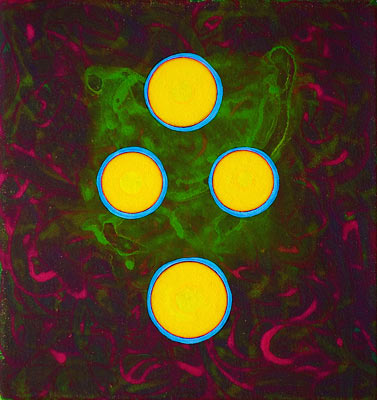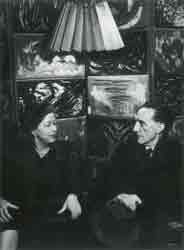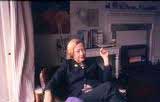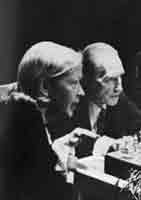Duchamp Introduced the Hypermedia
sitemap
drawings
paintings 1 2 3 4 4 5 a b c -
- A B . . . . . . . new
installations
projects
reviews
Oreste Pellegrini (1889-1971) |
Oreste Pellegrini (1889-1971) |
Duchamp Introduced the Hypermedia
John Toth
The Sublime: Art Media as Doubt*
It is here at this split between reason and imagination that the medium of the world slips into the media of the sublime, where the concept of ideas consumes the practical limitations of material substance and focuses on a noticing of life media. It is the creative space of the sublime where things start to happen. This is the place where imagination and reason reach their limit. In John Tancock’s article, The Influence of Marcel Duchamp, he describes the shift in the 1960’s when he begins to doubt the self-expression of Abstract Expressionism and its reliance on the artist's hand and the physical purity of painting. Tancock sees Duchamp’s attitude in a non-messianic manner, as if he were directing a new vanguard. However Duchamp describes his attitude as “Doubt in myself, doubt in everything. In the first place, never believing in truth.”[1]
Marcel Duchamp was one of the earliest, more philosophical new media pioneers, who understood the Kantian concept of the sublime. Duchamp invents a method he calls Readymades, to indicate that the medium of the art is already made. Duchamp merely arranges the parts in such a way as to create a new context. His new artworks begin to present a conceptual point-of-view that prompts Duchamp to say, “art is non-aesthetic,”[2] that is, the traditional sense of beauty is in the content or context of the artwork. Duchamp also presents a philosophical disruption of conventional logic, and says, “I would much rather breathe air than make art.”[3] Duchamp attacks the history of the idea of beauty and in doing so introduces a dialectical aesthetic through Readymade artworks that juxtaposed media in unexpected ways that evoke the sublime. In the light of this new aesthetic, beauty is no longer an end but something that emerges through the process of considering its antithesis. In this case we can call it a confrontation with an unknown or the sublime. By rejecting the notion of ‘beauty’ as an absolute, the work-of-art is more able to address the ideas of divergent and more complex issues. Art is free to address new issues: absurdity, humor, contradiction, satire trickery, jokes and parody.
Alexina Duchamp and Marcel Duchamp, the year after their wedding (1955).(Alexina Duchamp (1906–1995) was the second wife of Duchamp. Born Alexina Sattler in Ohio. She went to Paris to study art in 1921 and there she first met Marcel Duchamp in 1923 at a ball given in her honor by Mariette Mills, the mother of a close friend. In 1929 she married Pierre Matisse, the eldest son of Fauve artist Henri Matisse. They had three children. In 1949 Pierre and Alexina separated due to Pierre’s infidelity with Patricia Matta. She received in the subsequent divorce settlement many important paintings. She worked for a time as an agent/broker for artists such as Constantin Brâncusi and Joan Miró.)
Duchamp prefers a methodical doubt, writes Michel Sanouillet in Marcel Duchamp and The French Intellectual Tradition. Duchamp introduced an art that doubts the conventional tradition of aesthetics as beauty in the eye of the beholder and interrupts our way of experiencing a visual event. Duchamp’s concept of the Readymade questions the logic of an image that does not transmit a stimulus to the senses but to the mind. Sanouillet portrays this eloquently:
Duchamp seemed to those around him an intellectual, that is to say, an individual passionately interested in the adventures of the mind, in the cerebral play of thought and the delights of pure intellect.[4]
This notion of logic and play introduces a learning method of a higher order. The philosophical imperative to doubt means accepting contradiction as an interplay: a momentary truth that should not be taken as an absolute truth. What can lessons on the sublime teach us about the world we live in? For Duchamp the difference between painting and writing was non-existent. Both are optical stimuli that are received by our senses as the play of color, shapes and forms that must be deciphered by our mind through the presented signs and codes.[5] While someone might expect that Duchamp’s propensity for intellect would favor written language, he had a strong distrust for the literary tradition of his day which abhorred the lyricism of the Romantic Age; instead, Duchamp sought to intellectualize painting and sculpture.
Duchamp introduced an anti-aesthetic message to the art world that was in direct opposition to the remaining vestiges of 19th century Romanticism and embraces the machinery of the Industrial Revolution. Nude Descending a Staircase was painted in 1912 and reveals Duchamp’s visual understanding of the synthetic space of Matisse, the analytic cubism of Picasso and the futuristic dynamism of Boccioni. While the objectives of Futurism were largely an effort to anthropomorphize the dynamics of the machine, Duchamp’s approach was more of a conceptual artifice of the modern world that caused him to define the term Readymade. Tancock suggests that Duchamp immediately shifted to collage as a medium because the anonymous mechanically produced photographs used to make a collage, removed the trace of the individual and called attention to the context of art. In 1913 Duchamp created his first Readymade, (so called because the medium of art is manufactured).[6] Duchamp’s move to Readymades was mostly a result of his disinterest in the aesthetic implications of painting. A year later Duchamp says, “I want something where the eye and hand count for nothing.”[7] Forty-eight years after making his first Readymade Duchamp defined their characteristics: No beauty, no ugliness, nothing particularly esthetic about it.”[8] Here Duchamp seems to step outside of art. The normal procedures for assessing and judging art depended on a product to reflect on, through a visual literacy of line, form, color and mostly, a pictorial narrative. Duchamp, by removing the attraction or repulsion of taste, epitomized a Kantian shift from the aesthetic of the beautiful to the aesthetic of the sublime. It could be said that this shift beyond the knowable, beyond the senses, is just the place where thinking enters a quiet space that for a moment experiences the removal of self as a means of communication.
Alexina Duchamp. (Alexina Duchamp (1906 – 1995) was the second wife of artist and chess player, Marcel Duchamp.)
Sometime during 1916 Duchamp reproduced Bicycle Wheel[9] and posed a question about the meaning and relevance of the terms original and unique in regard to a work of art that is a copy. The significance of Duchamp’s question pre-dates Walter Benjamin’s philosophical exposition on “the copy” in The Work of Art in The Age of Mechanical Reproduction. Benjamin questions the philosophical legitimacy of the concept of an original in defining the value of a work of art. For Benjamin, that which is constructed is like a montage in which fragments reveal an understood whole. At the same time montage has a critical destructive dimension that interrupts the conventional concept of the image.[10]
Technology in the 21st century requires certain shifts in thinking about communication. Electronic media can be generated many times to produce exact clones. A digital artist can construct a virtual art object that exists as electronic signals, manipulated by the choices of the instrument's operator. Instead of painting on a canvas, a computer artist moves a mouse to create electronic data or optical signals that are burned onto metallic disks. The development of electronic technologies has pushed the arts and education into new territories. The transformation of media from analog to digital brings about a change in the way we think about communication.
Abject Media
Klaus Ottmann considers the place of the abject within the “genius” through the writing of Julia Kristeva who says “…Abject is the ambiguous; it lies “in-between, …between inside and outside, It straddles the Imaginary and the Symbolic.”[11] Kristeva situates the abject
... at the limit of primal repression’ in the drama that unfolds in Lacan’s Mirror Stage: As in Joussance where the object of desire,…bursts with the shattered mirror where the ego gives up its image in order to contemplate itself in the Other, there is nothing either objective or objectal to the abject. It is simply a frontier, a repulsive gift that the Other, having become alter ego, drops so that ‘I’ does not disappear in it but finds, in that sublime alienation, a forfeited existence.[12]
This may also be why Duchamp told Andy Warhol, that the only way for an artist to create something significant was to “go underground.”[13] Although Warhol didn't really seem to understand what Duchamp meant by this, it seems Duchamp had already made it clear in his Readymade art in stating his desire to remove himself from the art object. That is, Duchamp rejected the ”I” as an Ideal, that is always fixed on the other: Instead, Duchamp seemed to understand Lacan’s infans stage, which discovers an “I” that frees itself from the image of its other, hence Duchamp suggested that real art must go “underground” (the sublime alienation).
Duchamp consciously shifted his medium to collage so as to remove the traces of human personality and entered the world of the abject. The ideal identity of the artist disappears in favor of an “I” that does not grasp the whole. In Network of Stoppages, Duchamp used collage as a process that associates fragments into layers of networks. Abject diagrams, numbers, mechanical symbols and graphic designs appear layered over a (Cezanne like) aerial impression of a forested landscape. This technique is achieved through a deconstruction of an image that is cut up into fragments, as in collage or in film where montage images are superimposed or reconstructed into a new fragmented whole, and speaks to the dialectic nature of a knowledge system that considers the interplay of thesis and antithesis in the forming of its truths. This process destabilizes the narrative interpretation of an image and refocuses attention on noticing undiscovered associations between events. By cutting away and removing a part of an image, there is an accompanying urge to ask about what was cut away and why. Because each layer of a montage has a unique history, any one narrative could not express a sense of a whole event. Instead icons, sounds, animations and networking speak to multiple interpretations. This kind of thinking process becomes a key feature in the computer icon which becomes a carrier of multiple banks of images or information. Instead of a hierarchy of the images, Duchamp presents a multiplicity of decisions.
Marcel Duchamp may be the best known artist for defining the early process of conductive thinking that is facilitated by the network logic of an electronic media. The logic of a network allows for a global awareness that reveals unexpected associations, redundancies, poetics, strengths, flaws and unknowns. That Duchamp was comfortable in a variety of experiences suggests his practical application of network thinking. His work explores a variety of languages and mediums across disciplines: Duchamp embodies the imagination of an artist, the logic of a chess player, the eye of a filmmaker, the intrigue of a poet, the playfulness of a trickster, the discernment of a curator, the skills of a graphic designer and the disposition that is open to a dialectic. As a writer Duchamp was best known by the pseudonym, Rrose Selavy, his trans-identity. The epitome of abject media for Duchamp’s public was his Fountain,[14] a men’s urinal bought at “Mott Works” company, signed R. Mutt. Fountain was rejected by a jury-free exhibition as being immoral; Duchamp defended his creative process in 1917:
Now Mr. Mutt’s fountain is not immoral, that is absurd, no more than a bathtub is immoral. It is a fixture you see every day in plumbers’ show windows. Whether Mr. Mutt with his own hands made the fountain or not has no importance. He CHOSE it. He took an ordinary article of life and placed it so that its useful significance disappeared under the new title and point of view—created a new thought for that object.[15]
Kristeva further defines the dispassion of the abject ‘it dissituates,’ ‘it deterritorializes. …’it is a present out of place,”_a “nonsite”[16] Duchamp’s placing of the fountain in a horizontal position de-territorializes its common use. Its situation shifts from the bathroom wall to the gallery pedestal were it straddles common sense.
Electronic Media Across Modalities
Electronic technology opens the arts to another way of thinking about the art of communication. Duchamp inspired a network of artists around the world who developed a new art form called Intermedia art. The instrument of this new art form today is mostly the computer. Electronic technology opens new ways of thinking about how, why, where and when knowledge, meaning or expression is transmitted: The process of this new media is called hypermedia, because it is media that has the capability to link to related contextual sources. Hypermedia is embedded in technologies such as e-mail, electronic data bases, virtual reality games, word processors, spreadsheets and numerous electronic technologies. Using hypermedia requires new systems of logic that are discovered beyond the bounds of the traditional model of literacy. Hypermedia is a form of intermediation that facilitates the process of integrating multiple knowledge modalities.
Alexina Duchamp and Marcel Duchamp
Duchamp‘s numerous experimentations with media, diverse ways of thinking and facility across disciplines epitomizes interdisciplinarity. Thinking in a variety of media, Duchamp maintains a sense of play as he hones a visual idea: All media is subject for thought, from physical properties to four dimensional theories on space/time that Duchamp understood through conversations he had with his close friend Maurice Princet, a mathematics theorist. Duchamp’s visual understanding of space/time is apparent in his 1913 painting, Nude Descending a Staircase. Through transparent and opaque repetitions of fragments of a body, the illusion of a person moving through time is presented. Duchamp’s painting, Network of Stoppages is another good example of Duchamp’s experimentation with space-time reality in which a diagrammatic schemata (matheme) of a four dimension space/time situation is presented. In his Readymade artworks the four dimensional space/time situation occurs in the mind and lingers in play like the strategic thinking one engages in during a chess game. In 1968 Duchamp collaborated with John Cage in creating an electronic chessboard that triggered sounds as each chess piece is moved. The chess game becomes a musical score. To record his chess games Duchamp made little stamps to print the “game moves” in his notebooks. Duchamp reveals throughout his life the ability to shift between knowledge modalities so as to create and transform his art through an interdisciplinary process. Collaboration of this sort is not just a purely intellectual experience because the thinking is seated in an active medium. The context of medium for Duchamp and Cage, on the other hand is a matter of thinking that is set into play by imaginatively considering new relationships in the elements across disciplines. Music composer John Cage's a fascination for numbers occurs from chance operations and indeterminacy. Cage found in Duchamp an artist who could think outside the elements of his domain, thinking through media outside the conventional methods of a discipline.
Cage would organize sound with the throw of a dice or a computer program that generated random numbers. Chance operations as a compositional choice, allowed Cage to explore networks as a compositional process. HPSCHD[17] by John Cage and Lejaren Hiller utilized multiple concurrent harpsichord performances through a large environment of projection screens displaying 50 simultaneous films and 50 sequencing slide projectors with images generated from NASA and public media. Many artists from Dada, Surrealism through the 1950-60, have pioneered electronic artworks that generated collaborations across modalities. For more examples of Intermedia artists on the Internet you can hyperlink to John Cage, Merce Cunningham, Jasper Johns, Alwin Nikolais, Fluxus, The Wooster Group.
Hypermedia as Apparatus: Media Literacy
The book as a media system introduces us to the term literacy. How do systems of learning transform over time? Prior to written languages, dance, music, drawing, painting, sculpture and architecture signified the knowledge and history of the past. When spoken language was first recorded it was scribed into pictographs that symbolically reflected a history of experience. Prior to written history, the way knowledge was transferred from generation to generation was by oral recitation. It took a thousand years for written language to become available to the masses. How did the invention of the printing press affect literacy? How does the mass ownership of books by individuals affect social relationships? Through Guttenberg’s printing press the great books of knowledge could be copied or translated to multiple languages and be sold across the world. World knowledge was available in a new way.
Hyper-literacy in the 21st century provides a new world perspective that is immediate and lived in the moment through a new electronic apparatus. How does the use of electronic media, further transform literacy? Literacy as we know it is being transformed by electronic media. A professor of English, Gregory Ulmer has a name for the new literacy called “electracy” and in his book Heuretics: The Logic of Invention he describes how knowledge is transmitted through the medium of electricity. This novel way of approaching knowledge requires some new considerations. The invention of the camera becomes the apparatus that begins to displace literacy. ”A picture is worth a thousand words,” makes such a claim. Ulmer believes this shift does not replace literacy but exists alongside it. Or perhaps we are living in a hybrid state: “electracy” as a process of knowledge uses computers as a means of generating a virtual or hyper reality. The letter is to literacy as the e-mail is to hypermedia. Hypermedia as such is different from the letter in that the letter takes days to deliver through manual carriers, while the e-mail is sent, for all practical purposes, instantly. The medium of hypermedia is electrons, particles and light but its real contribution as a knowledge system is that it has as its main property an ability to explore knowledge instantly: hypermedia is present and available through the internet. The disadvantage of this new media, however, is that it brings with it problems: issues of privacy, identity theft, worms, bugs, security and loss of data. Ulmer suggests that the use of the image carries an important role as an icon in the language of computer technology. Ulmer is seeking to define a method for creativity in Benjamin’s work, specifically The Arcades Project.
Ulmer's search for a creative method considers Benjamin’s notion of the “composers card box”160 which Ulmer sees as a pre-writing database: “the user of the database . . . encounters in principle the full paradigm of possibilities through which a multitude of paths may be traced.” Ulmer describes academic writing, largely, as a cause and effect logic of argumentation that follows a linear path towards a deduced, “right answer.” With hypermedia, a database or information is organized in a network, and meaning is constructed through a conductive associational logic that occurs through a non-linear method. In hypermedia there are usually many solutions to a problem; the truth in any one given interpretation destabilizes any totality and what remains are multiple points of view that realize a moment of truth. Academic literacy favors the product and hypermedia favors the process.
Because each layer of a hypermedia is a unique history, any one narrative could not express a sense of a whole event. Instead icons, sounds, animations and networks of different points of view are available for inquiry: knowledge is actively experienced in hypermedia rather than merely described as in a lecture on knowledge.
* John Toth; The Space of Creativity: Hypermediating the Beautiful and the Sublime, European Graduate School - Dissertation, September 2005, pp. 69-79.
Notes:
[1] John Tancock's article, The Influence of Marcel Duchamp, p. 165.
[2] Ibid. p. 165.
[3] Marcel Duchamp quotes at Zaadz, Inc. URL: http://zaadz.com/quotes/authors/marcel_duchamp/
[4] Ibid. 48.
[5] Michel Sanouillet in Marcel Duchamp and The French Intellectual Tradition, p. 48.
[6] Ibid. p. 161.
[7] John Tancock's article, The Influence of Marcel Duchamp, 161.
[8] Museum of Modern Art , catalog, p. 279.
[9] Marcel Duchamp. Bicycle Wheel. Readymade: bicycle wheel, diameter 64.8 cm. mounted on a stool, 60.2 cm high. Original lost.
[10] Benjamin, Walter. “The Work of Art in The Mechanical Age of Reproduction”. Continental Aesthetics: Romantiscm to Postmodernism. Ed. Richard Kearney and David Rasmussen. Chicago: Blackwell. 2001 (1936), p. 75.
[11] Kristeva in Klaus Ottmann, The Genius Decision, p. 35.
[12] Klaus Ottmann, The Genius Decisioin, p. 34.
[13] Warhol, Andy and Pat Hackett. POPism: The Warhol ‘60's. New York: Harper & Rowe, Publishers. 1980. p. 47.
[14] Marcel Duchamp, Fountain. 1917. Readymade: porcelain urinal. Height 60 cm. Philadelphia Museum of Art.
[15] D'Harnoncourt, Anne and Kynaston McShine. Marcel Duchamp. New York: Museum of Modern Art and the Philadelphia Museum of Art. 1973. p. 283.
[16] Klaus Ottmann, The Genius Decisioin, p. 32.
[17] HPSCHD by John Cage and Lejaren Hiller. 1960.




